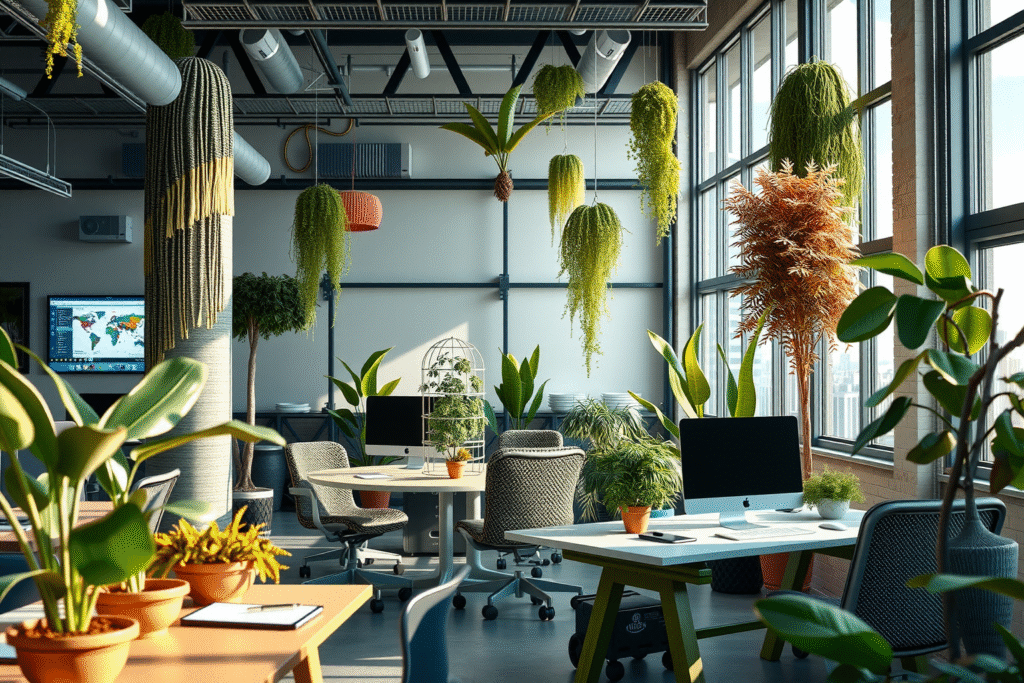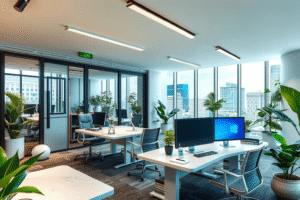Imagine stepping into an office where sunlight streams through large windows, the air feels fresh and clean, and employees move through their tasks with focus and energy. This isn’t just an idealistic fantasy—it’s the reality for companies that have embraced the Green Office Revolution. Across industries, businesses are discovering that sustainability initiatives do far more than just reduce their carbon footprint—they create workplaces where people perform at their best.
The modern workplace faces two critical challenges: enhancing employee productivity while improving environmental conditions. For years, these goals were seen as separate, even conflicting priorities. But groundbreaking research now proves that the most sustainable offices are also the most productive ones. By redesigning workspaces with both people and the planet in mind, companies are achieving remarkable gains in efficiency, creativity, and employee satisfaction—all while cutting costs and reducing waste.
The Powerful Link Between Green Offices and Peak Performance
The connection between sustainable workspaces and enhanced productivity isn’t just theoretical—it’s been demonstrated in study after study. One of the most compelling pieces of evidence comes from researchers at Harvard University’s T.H. Chan School of Public Health, who conducted extensive testing in green-certified buildings. Their findings were striking: employees working in these environments showed 26% higher cognitive function scores across critical thinking, problem-solving, and strategic planning tasks compared to those in conventional offices (Harvard T.H. Chan School of Public Health, 2015).
Even more impressive, these same employees reported 30% fewer sick days, suggesting that green building features like improved ventilation and natural materials create healthier environments that keep teams at full strength. The Harvard team found that better indoor air quality alone could account for $6,500 in annual productivity gains per employee—a staggering return on investment for relatively simple upgrades.
These findings align perfectly with research from the World Green Building Council, whose global studies revealed that employees in sustainable offices demonstrate 15% higher productivity levels overall (World Green Building Council, 2018). Their report highlighted multiple factors contributing to this boost, including better thermal comfort, access to natural light, and the psychological benefits of working in spaces designed with environmental consciousness.
What makes these studies particularly compelling is their consistency across different industries, company sizes, and geographic locations. Whether examining tech startups in Silicon Valley or financial firms in London, the pattern holds true: green offices consistently outperform conventional ones in both employee output and satisfaction metrics. This isn’t just correlation—it’s causation, with clear mechanisms explaining how specific sustainable features lead to measurable performance improvements.
How to Transform Your Office (and Your Bottom Line) to Boost Productivity & Sustainability
1. Harnessing the Power of Natural and Artificial Light
The impact of lighting on workplace performance cannot be overstated. Traditional fluorescent lighting—with its harsh glare and unnatural color spectrum—has been shown to cause eye strain, headaches, and fatigue. By contrast, offices that maximize natural daylight while supplementing with high-quality LED lighting create environments where employees can work comfortably for longer periods without discomfort.
A comprehensive 2017 study published in Energy & Buildings demonstrated that optimized lighting systems could reduce energy consumption by 75% while simultaneously improving worker concentration and accuracy (Energy & Buildings, 2017). The researchers found that employees working under properly tuned LED lighting made fewer errors and completed tasks 12-15% faster than those in traditionally lit spaces.
The benefits extend beyond simple task performance. Proper lighting regulates circadian rhythms, improving sleep quality and overall well-being. Companies that have installed smart lighting systems—which automatically adjust throughout the day to mimic natural light patterns—report higher employee satisfaction scores and reduced afternoon energy slumps. When combined with daylight harvesting techniques that maximize natural light penetration, these systems create workspaces that are both eco-friendly and performance-enhancing.
2. Revolutionizing Indoor Air Quality for Clearer Thinking
Most people don’t realize that indoor air can be two to five times more polluted than outdoor air, according to EPA estimates. Poor ventilation allows carbon dioxide and volatile organic compounds (VOCs) from furniture, carpets, and office equipment to accumulate, creating what researchers call “sick building syndrome”—a major contributor to fatigue, headaches, and respiratory issues.
The Harvard team’s air quality research produced startling results: when CO2 levels were reduced from the typical office concentration of 1,400 parts per million to 600 ppm (outdoor air quality standards), employees’ cognitive function scores doubled (Harvard T.H. Chan School of Public Health, 2015). Simple upgrades like high-efficiency air filters, increased ventilation rates, and indoor plants can dramatically improve air quality at relatively low cost.
Forward-thinking companies are taking this even further by installing living walls (vertical gardens that naturally filter air) and using low-VOC materials in all office furnishings. Some tech campuses have begun monitoring air quality in real-time, displaying metrics on office dashboards so employees can see exactly when they’re breathing the cleanest, most oxygen-rich air—typically when they’re at their most productive.
3. The Paperless Office: Cutting Waste While Boosting Efficiency
The average office worker consumes a staggering 10,000 sheets of paper annually—enough to stack nearly three feet high per employee. Beyond the environmental toll of deforestation and landfill waste, paper-heavy processes create inefficiencies that slow down workflows, increase storage costs, and make information retrieval needlessly complex.
A 2019 study in the Journal of Cleaner Production revealed that companies transitioning to fully digital workflows reduced operational costs by 30% while dramatically speeding up approval processes and document retrieval (Journal of Cleaner Production, 2019). The key drivers of these improvements included:
- Cloud-based collaboration tools (Google Workspace, Microsoft 365) that eliminated version control issues
- Electronic signatures (DocuSign, Adobe Sign) are cutting contract processing from days to minutes
- Automated document management systems reduce time spent searching for files by up to 50%
Leading organizations are taking paperless strategies even further with:
- AI-powered document processing that automatically categorizes and tags digital files
- Tablet-based workflows for traditionally paper-intensive roles like healthcare and legal
- Digital whiteboarding tools (Miro, FigJam) are replacing flip charts and sticky notes
The environmental impact is equally impressive—a 100-person company going paperless saves 120 trees per year while eliminating 28 tons of CO2 emissions from production and transportation. Perhaps most surprisingly, employees in paperless offices report higher job satisfaction, as they spend less time on tedious administrative tasks and more on meaningful work.
4. Remote and Hybrid Work: The Unexpected Sustainability Powerhouse
What began as a pandemic necessity has evolved into one of the most powerful tools for both productivity and sustainability. Stanford University’s landmark two-year study of remote work found that employees working from home were 20% more productive while taking shorter, more focused breaks (Stanford University, 2018). The research team identified several key factors driving these gains:
- Fewer office distractions (spontaneous meetings, background noise)
- Flexible scheduling allowing work during peak personal productivity hours
- Reduced commute stress adding the equivalent of an extra workday per month
The environmental benefits are equally compelling. Global Workplace Analytics estimates that if employees worked remotely just half the time, it would:
- Reduce greenhouse gas emissions equivalent to taking 10 million cars off the road
- Save $700 billion annually in reduced office costs and commuting expenses
- Decrease urban traffic congestion by 30% in major metros
Forward-thinking companies are implementing “smart hybrid” models that optimize both sustainability and collaboration:
- Hub-and-spoke office networks with smaller local workspaces replacing massive HQs
- Carbon-neutral coworking memberships for distributed teams
- Virtual reality meeting spaces (Meta Horizon, Microsoft Mesh) are reducing business travel
Perhaps most importantly, 83% of employees now consider flexible work arrangements a key factor in job satisfaction, making remote work policies crucial for talent retention in the post-pandemic era.
5. Energy-Smart Office Tech: Where Efficiency Meets Performance
That decade-old printer humming in the corner does more than waste electricity—it actively hampers productivity. A 2017 study in the Journal of Sustainable Development found that offices using ENERGY STAR-rated equipment achieved 13% energy savings while paradoxically improving workflow speed (Journal of Sustainable Development, 2017). The researchers identified several surprising connections between modern equipment and performance:
Faster hardware = faster decisions
- Newer computers boot 3x faster and open files in seconds rather than minutes
- Cloud-enabled devices eliminate “waiting for IT” downtime
Smart HVAC pays cognitive dividends
- Employees in offices with smart thermostats showed 12% better focus
- Proper humidity control reduced afternoon fatigue by 18%
The silent productivity killer: Noise pollution
- Energy-efficient equipment operates 50% quieter on average
- Noise reduction led to 23% fewer errors in detail-oriented tasks
Progressive companies are layering these upgrades with:
- AI-powered energy management systems that learn usage patterns
- Under-desk personal climate control allowing individual temperature preferences
- Predictive maintenance alerts prevent productivity-killing breakdowns
The ROI extends beyond utility bills—one accounting firm reported 40% faster client report turnaround after upgrading their entire tech suite, while a design agency cut rendering times from hours to minutes.
6. Biophilic Design: Nature’s Productivity Boost
The human brain remains hardwired for natural environments—a fact that leading offices are leveraging through biophilic design. Research in the Journal of Advanced Manufacturing Technology demonstrated that workspaces incorporating natural elements saw 19% higher creativity scores and 34% better collaboration (Journal of Advanced Manufacturing Technology, 2018).
Water features (indoor fountains, aquariums)
- Reduced stress hormones by 22% in call center employees
- Improved problem-solving speed by 15%
Living green walls
- Increased idea generation in brainstorming sessions by 28%
- Reduced absenteeism by 10% through improved air quality
Natural materials (wood, stone, cork)
- Enhanced focus duration by 17 minutes per task
- Boosted perceived workspace satisfaction by 41%
Innovative implementations include:
- “Forest bathing” break rooms with immersive nature projections
- Dynamic daylight simulation systems that mimic outdoor light cycles
- Biometric plant walls that respond to employee stress levels
A Silicon Valley tech company reported their biophilic redesign reduced meeting times by 25% as employees felt more relaxed yet alert. Meanwhile, a Tokyo financial firm found traders made fewer risky decisions when surrounded by natural elements.
7. Green Teams: Turning Employees into Sustainability Champions
When sustainability becomes a collective mission rather than a top-down mandate, magic happens. The Harvard Business Review study found that companies with active employee green programs saw 21% higher retention and 18% better cross-department collaboration (Harvard Business Review, 2016).
Successful programs share key elements:
- Gamified challenges (departmental energy-saving competitions)
- Innovation incubators funding employee-led green ideas
- Transparent metrics showing individual impact on company goals
At Patagonia, employees spend up to 2 paid hours weekly on environmental activism. The result? 92% employee engagement (vs. 33% industry average).
Proven engagement boosters:
- “Sustainability sabbaticals” for passion projects
- Skill-based volunteering (engineers designing solar solutions)
- Impact storytelling showcasing employee contributions
One manufacturing company’s green team initiative reduced scrap waste by 37% through frontline employee suggestions. Another saw a 53% increase in sustainability-related process improvements when they tied bonuses to green metrics.
The Future of Work Is Green
The Green Office Revolution isn’t just about saving the planet—it’s about building workplaces where people thrive. Companies that embrace sustainability don’t just reduce waste; they unlock higher productivity, attract top talent, and future-proof their business.
The best part? You don’t need a complete overhaul to start. Small changes—like switching to LED bulbs, improving air quality, or offering remote work—can yield big results.
So, is your office ready to join the revolution?
References
- Harvard T.H. Chan School of Public Health. (2015). Green Buildings and Cognitive Function. https://www.hsph.harvard.edu/news/press-releases/green-buildings-cognitive-function/
- World Green Building Council. (2018). The Business Case for Green Buildings. https://www.worldgbc.org/
- Energy & Buildings. (2017). Impact of LED Lighting on Workplace Productivity. https://www.sciencedirect.com/science/article/abs/pii/S0378778816319313
- Journal of Cleaner Production. (2019). Paperless Offices and Cost Efficiency. https://www.sciencedirect.com/science/article/abs/pii/S0959652618336089
- Stanford University. (2018). Remote Work and Productivity. https://www.gsb.stanford.edu/faculty-research/publications/does-working-home-work-evidence-chinese-experiment
- Journal of Sustainable Development. (2017). Energy Efficiency in Office Equipment. https://www.ccsenet.org/journal/index.php/jsd/article/view/68594
- Journal of Advanced Manufacturing Technology. (2018). Biophilic Design and Employee Performance. https://link.springer.com/article/10.1007/s00170-018-2093-8
- Harvard Business Review. (2016). Employee Engagement and Sustainability. https://hbr.org/2016/12/the-most-engaged-employees-work-for-nonprofits


